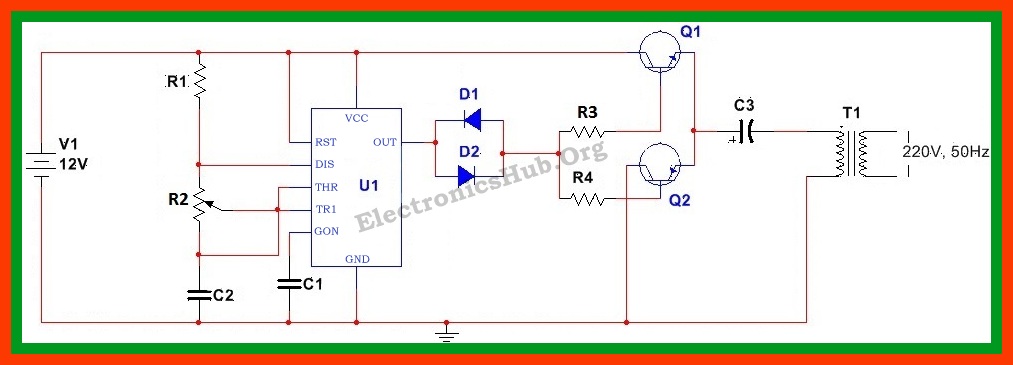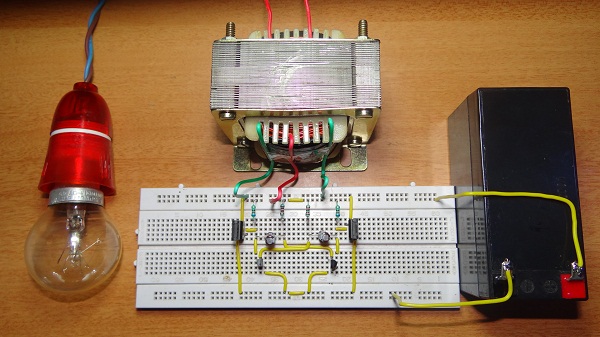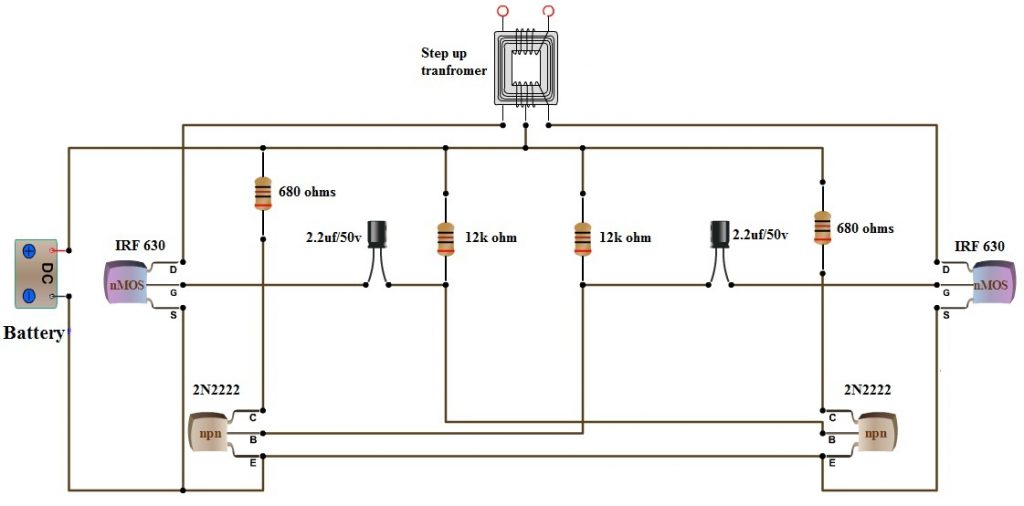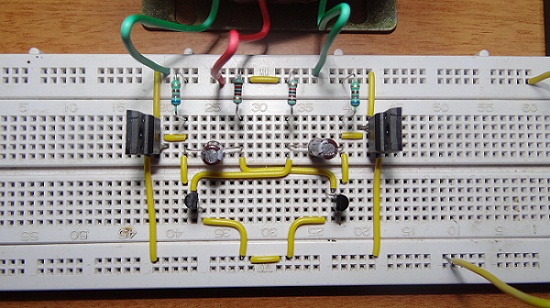Inverters are often needed at places where it is not possible to get AC supply from the Mains. An inverter circuit is used to convert the DC power to AC power. Inverters can be of two types True/pure sine wave inverters and quasi or modified inverters. These true /pure sine wave inverters are costly ,while modified or quasi inverters are inexpensive.
These modified inverters produce a square wave and these are not used to power delicate electronic equipments . Here, a simple voltage driven inverter circuit using power transistors as switching devices is build, which converts 12V DC signal to single phase 220V AC.
12V DC to 220V AC Converter Circuit Principle
The basic idea behind every inverter circuit is to produce oscillations using the given DC and apply these oscillations across the primary of the transformer by amplifying the current. This primary voltage is then stepped up to a higher voltage depending upon the number of turns in primary and secondary coils.
Also get an idea about 12V to 24V DC Converter Circuit
Inverter circuit Using Transistors
A 12V DC to 220 V AC converter can also be designed using simple transistors. It can be used to power lamps up to 35W but can be made to drive more powerful loads by adding more MOSFETS.
The inverter implemented in this circuit is a square wave inverter and works with devices that do not require pure sine wave AC.
Circuit Diagram
Components required
- 12v Battery
- MOSFET IRF 630 -2
- 2N2222 Transistors
- 2.2uf capacitors-2
- Resistor
- 680 ohm-2
- 12k-2
- 12v-220v center tapped step up transformer.
Working
The circuit can be divided into three parts: oscillator, amplifier and transformer. A 50Hz oscillator is required as the frequency of AC supply is 50Hz.
This can be achieved by constructing an Astable multivibrator which produces a square wave at 50Hz. In the circuit, R1, R2, R3, R4, C1, C2, T2 and T3 form the oscillator.
Each transistor produces inverting square waves. The values of R1, R2 and C1 (R4, R3 and C2 are identical) will decide the frequency. The formula for the frequency of square wave generated by the astable multivibrator is
F = 1/(1.38*R2*C1)
The inverting signals from the oscillator are amplified by the Power MOSFETS T1 and T4. These amplified signals are given to the step-up transformer with its center tap connected to 12V DC.
Output Video
By using a 24V battery, loads up to 85W can be powered, but the design is inefficient. In order to increase the capacity of the inverter, the number of MOSFETS must be increased.
To design a 100 watt Inverter read Simple 100 Watt inverter
12v DC to 220v AC Converter Circuit Using Astable Multivibrator
Inverter circuits can either use thyristors as switching devices or transistors. Normally for low and medium power applications, power transistors are used. The reason for using power transistor is they have very low output impedance, allowing maximum current to flow at the output.
One of the important applications of a transistor is in switching. For this application, the transistor is biased in saturation and cut-off region.
When the transistor is biased in saturation region, both the collector emitter and collector base junctions are forward biased. Here the collector emitter voltage is minimum and collector current is maximum.
Another important aspect of this circuit is the oscillator. An important use of 555 Timer IC is in its use as an astable multivibrator.
An astable multivibrator produces an output signal which switches between the two states and hence can be used as an oscillator. The frequency of oscillation is determined by the values of capacitor and resistors.
[Also Read: How To Make an Adjustable Timer ]
Circuit Diagram

Circuit Components
- V1 = 12V
- R1 = 10K
- R2 = 150K
- R3 = 10Ohms
- R4 = 10Ohms
- Q1 = TIP41
- Q2 = TIP42
- D1 = D2 = 1N4007
- C3 = 2200uF
- T1 = 12V/220V step up transformer
Circuit Design Explanation
Oscillator Design:An astable multivibrator can be used as an oscillator. Here an astable multivibrator using 555 timer is designed. We know, frequency of oscillations for a 555 timer in astable mode is given by:
f = 1.44/(R1+2*R2)*C
where R1 is the resistance between discharge pin and Vcc, R2 is the resistance between discharge pin and threshold pin and C is capacitance between threshold pin and ground. Also the duty cycle of the output signal is given by:
D = (R1+R2)/(R1+2*R2)
Since our requirement is f =50Hz and D = 50% and assuming C to be 0.1uF, we can calculate the values of R1 and R2 to be 10K and 140K Ohms respectively. Here we prefer using a 150K potentiometer to fine tune the output signal.
Also a ceramic capacitor of 0.01uF is used between the control pin and ground.
Switching Circuit Design:Our main aim is to develop an AC signal of 220V. This requires use of high power transistors to allow the flow of maximum amount of current to the load. For this reason we use a power transistor TIP41 with a maximum collector current of 6A, where the base current is given by the collector current divided by the DC current gain. This gives a bias current of about 0.4A *10, i.e.4A. However since this current is more than the maximum base current of the transistor, we prefer a value less than the maximum base current. Let us assume the bias current to be 1A. The bias resistor is then given by
Rb = (Vcc – VBE(ON))/Ibias
For each transistor, the VBE(ON) is about 2V. Thus Rb for each is calculated to be 10 Ohms. Since the diodes are used for biasing, the forward voltage drop across the diodes should be equal to the forward voltage drops across the transistors. For this reason, diodes 1N4007 are used.
The design considerations for both the PNP and NPN transistors are same. We are using a PNP power transistor TIP42.
Output Load Design: Since the output from the switching circuit is a pulse width modulated output, it might contain harmonic frequencies other than the fundamental AC frequency. For this reason, an electrolyte capacitor needs to be used to allow only the fundamental frequency to pass through it. Here we use an electrolyte capacitor of 2200uF, large enough to filter out the harmonics. Since it is required to get 220V output, it is preferred to use a step up transformer. Here a 12V/220V step up transformer is used.
12v DC to 220v AC Converter Circuit Operation
- When this device is powered using the 12V battery, the 555 timer connected in astable mode produces square wave signal of 50Hz frequency.
- When the output is at logic high level, diode D2 will conduct and the current will pass through diode D1, R3 to the base of transistor Q1.
- Thus transistor Q1 will be switched on. When the output is at logic low level, diode D1 will conduct and current will flow via and D1 and R4 to the base of Q2, causing it to be switched on.
- This allows the DC voltage to be produced across the primary of the transformer at alternate intervals. The capacitor ensures that the frequency of the signal is at the required fundamental frequency.
- This 12V AC signal across the primary of the transformer is then stepped up to 220V AC signal across the transformer secondary.
Applications of 12v DC to 220v AC Converter Circuit
- This circuit can be used in cars and other vehicles to charge small batteries.
- This circuit can be used to drive low power AC motors
- It can be used in solar power system.
Limitations
- Since 555 Timer is used, the output may slightly vary around the required duty cycle of 50%, i.e. exact 50% duty cycle signal is hard to achieve.
- Use of transistors reduces the efficiency of the circuit.
- Use of switching transistors has the possibility of causing cross over distortion in the output signal. However this limitation has been reduced to some extent by the use of biasing diodes.
Note
Instead of 555 timer one can use any astable multivibrator. For example this circuits can also be build using 4047 astable multivibrator,whose output current is amplified and applied to the transformer.
[Read: Solar Inverter for Home]





106 Responses
What is the power specification of 12v DC battery(current)?
Have you practically did this project?
I think the current rating of the battery is 7.5 ampere.
Hey I am build the ckt using IRF630 but the output of transformer gives 50v…I can’t understand vwhats the problem can any one tell me plz???
the problem is that you are using low current holding component it holds up to 200 v but what about A what’s your value for A? may be that will help me solve your problem
Can u tell me the IC name…which is used in this project
IC 555
Here 555 timer is used
IC CD4047
thats i want to know
air what rate of maximum power load applied this ckt
I USE SAME CIRCUIT AS PICTURE 1 DOING SIMULATION ON MULTISIM STILL CANT GET DESIRED VALUE
i need a electrical minor project but i am not understanding what should i present amd also i have no idea about it so please help me
I design wxactly that circuit with input 16 volts..but across 2200 uF capacitor,the voltage A.C is 30 volts but transformer does not step up this voltage and i didnt found any voltage across transformer.
I got around 95v AC across x-mer
what type of output signal can we get from this circuit? Sine or square wave?
It is a square Wave
Can we create deadtime for wave output?
what is c1 and c2 values?
I learn more
What microfarade of C1 and C2 ?
c1= 0.1uf and c2=0.1nf
12v,Battery
Discharged by inventor to AC. 220v. Load. Can it be used as a converter AC to charge the 12v. Battery.
awesome
Is it really working for anyone? (inveter using transistor(IRF630))
The circuit is tested ..it is working
what is the specification of the battery u have used ?
12V @ 3.3Ah
i hv tried but on connecting transformer the 12v battery supply is being getted shorted ……..can u suggest what is the problem…………..i hv implemented the ckt as per the given dig. and transformer is also of the same rating
Intresting
i have constructed the circuit using multisim with transistors , TIP 41CG , And TIP 42CG but when i run the simulation switch the IC 555 timer output gets burst in the simulation . and i cannot see any output voltage across the transformer of course, How every i have thoroughly circuit once again but couldn’t find out where the problem is ?
Can any one help me please where might the problem could be ?
Will it work with IRF540 &510 Mosfets??
The inverter is designed for a power of 25-30W and the maximum current drawn will be less than 2A. The IRF630 can be used up to 9A (temperature dependent) of drain current. IRF540 can be used up to 28A of continuous drain current and IRF510 can be used up to 5.6A. So, IRF510 can be used in this circuit. If you are designing an inverter for higher power, then you can use IRF540.
But what will be the effect on the battery if i used IRF540 OR IRF630
what is the purpose of C3 …?
During the positive pulse, Q1 will be ON and the current flows from Q1 to T1 via C3. During this time, C3 will be charged and is in normal polarity. During the negative pulse, Q2 will be ON. C3 will discharge via Q2 and the flow of current will be from T1 to Q2 via C3. So, C3 will help in generating an alternating wave.
Thank YOU!!!!
can I use IRF 510 or 540 ??
What’s the power rating of the battery
whats is the minimum current for the inverter to be operative(minimum laod current)
Minimum current for the inverter circuit can be calculated by adding the current flowing in the circuit alone (without transformer) and the open circuit current of the transformer.
Can u give me the link of buying ic
hai can i use IRC640?
The inverter is designed for a power of 25-30W and the maximum current drawn will be less than 2A. The IRF630 can be used up to 9A (temperature dependent) of drain current. IRF640 can be used up to 18A of continuous drain current. If you are designing an inverter for higher power, then you can use IRF640.
Hi. What is the rating of battery. Shall you tell me the specification of battery and transformer please..
I built and tested the dc to ac inverter using the 555 timer. I am getting a max of 6.36 Vac on the primary side of the transformer and 46 vac on the secondary side of the transformer. Do you have any idea what the issue may be? I have tinkered with the potentiometer with no luck. I have followed the instructions above. The only difference is that I am using a 12V to 120 V transformer. Thanks for your time.
Disregard this comment as well, I understand what I was doing wrong after reading your post. I learned so much about transformers and astable multivibrators from doing this project. Keep up the good work.
I built the same circuit (IRF 630), everything is ok except that output is just 55-60V instead of 220V.On primary side of transformer voltage is 24V,(which is the required voltage ) showing that the circuit is working fine.If I plug in transformer directly into 220 V mains it gives 24V which shows that transformer is also working fine.Please tell what is the problem.
What’s the purpose of ceramic capacitor between the control pin and ground?
How did you calculate the C3 value?
if you know tell me
I built both DC to AC inverters and I understand most of it conceptually with the exception of the transistor, resistors, and capacitor acting as the oscillator. How do the transistor, resistor, and capacitor components make up the oscillator? Can you please explain? Thank you.
how to many amps transformer can be used in first given circuit and also in other circuit using ic 555 timer
Please give power rating of battery as well as transformer of the tested design.I want make this circuit but without power rating it is not possible
what is the volt for 2.2uf capacitor
This circuit is low power. Very interesting. thank you
Does it work Irf630 Inverter
does this inverter work becaue i made it but it did not work It gives 0 V output(irf630) if someones work please share
Pls. Can you sell this project panel for me
pls sir if there is an increase in the number of MOSFET will there be an increase in the other components ie the equipment in other to be able to carry more load thanks
the transistor you used must it be IRF630 transistor or can i use IRF540 transistor
Hello,
the project is interesting… 😀
may i know how much the Amper-Hour (Ah) of the battery?
hi can i use 12-0-12 v 3a transformer
or 12-0-12 10a tranformer
Tell the full transformer rating 12 to 220 v And how many ampers required…. Tell me
Great project …
It is possible to produce exact sine wave
can i purchage this circuit?
What the type of the transformmer, i tried find at shop but they they said there were no transformer like that.. Can u describe the transformer the type??how much amp??
where can i get that step up transformer ?
What is the wire sizes of the primary winding and secondary winding of the transformer?
Hi, The output depends on the transformer.
The 60-Hz`s transformer is too expensive.
Can you please tell me the ratings of transformer?…. What is the rated current of the transformer ?…
220V to 12V Center Tapped Transformer rated at 3Amps.
Yea you can use it BT the problem is power loss will occour in the circuit.
Sir resistor 12k and 680ohms the watts ? Cann i use 12k and 680 ohms 1watt
yes.
This circuit is working but output power is very low. How can we improve the output power?(for inverter circuit using IRF630)
How long would it last using a battery specs of 12V, 4AH and a load of 50W?
Thank You
What about
the polarity of the capacitors?
output is square
how can we achieve sine?
How many range of component?
We try this circuit ( irf630 ) we get 210 output but your shown breadboard connection are wrong so do your own connection as per circuit diagram ..n thank u .
I am getting 110v output instead of 220v by using IRF630 nmosfet inverter circuit. How can i get 220v output ?
what is the rating of transformer ?
If the input of my transformer is 12vdc and output 220vac current is 1.5A,
1 what is the output wattage
2 can I use the first circuit instead of the second
3 what is the difference between the two circuits on this page since both are square wave.
Thanks
yes u can used the first one
satisfactory
i love it
Is It Possible????
how can i build it to power 200w
i needlow power range
i like this
can I use a mini wind turbine instead or in absence of battery??
sir ido 1st project using transistor but iget 163v,110hz. how i can get exact 230v and 50hz?
May I know please the irf I can use and the capacitors I can use to give me an output of 240v ac
What is the amp here of transformer used in 12 220v ac inverter
Hello i love your design, i designed it too with IRF 830 andi had a problem of incosistency.I mean the AC supply was not consistent once i plug the battery, and at a time one of my 2N2222 transistors burnt, pls any suggestions to solve my problem?
Please my 2N2222 transistor keeps burning when i run the circuit on 12v battery what do u think is my problem?
These circuits are good for learning some basics of switching supplies but are not meant for anything else, or shouldn’t be meant for anything else. You will not get reliable operation from these types of circuits.
which software avaliable for to designe and simulate the Circuit Diagram of 12v DC to 220v AC Converter
Anyone can give me DC 12v to AC 220V, 5000Watt Circuit Diagram?
how many watts,is the inverter?
amazing bro can use this for solar panel
How do you convert DC to AC?
Great article and very well researched.
Please I have a growatt inverter 5kva 48v HVM. It output frequency is 65hz as against the set 50hz. And when there is an input supply from the grid, the input voltage keeps dropping till the inverter starts showing error 10 which means output power derating. What component in the inverter can be the cause of this problem
How to subscribe this page ? I like this page ❤️ and thanx for give same knowledge to me 😃
Could this be used to run a 2kw heater ?
Also , how long would the 12v battery last to run it ?